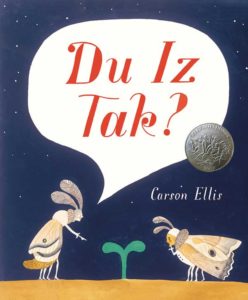Du Iz Tak?
Reviewed by Margaret T. Walden
May 1, 2017
 By Carson Ellis. Candlewick Press, 2016. 48 pages. $16.99/hardcover. Recommended for ages 4–8.
By Carson Ellis. Candlewick Press, 2016. 48 pages. $16.99/hardcover. Recommended for ages 4–8.
Buy from QuakerBooks
On the opening pages of Du Iz Tak?, a caterpillar, wearing an improbable number of shoes, clambers along the underside of a twig, dangles there by the last two of those shoes, then says, “Ta ta!” and wraps herself into a well-formed chrysalis. A tiny green plonk appears and is observed and discussed by three insects as it produces a pair of leaves and then another pair of leaves. Uncertain about what they have found, they determine that they need a ribble to climb the plonk, and so troop off to the home of a pill bug named Icky to borrow his. The insects construct a furt in the growing plonk but then an eight-legged booby foobek takes up residence in the plonk’s upper leaves. An element of sorrow enters the story when a bird captures the booby foobek and carries it away. The insects are all downcast.
Eventually the plonk produces a colorful scrivadelly gladdenboot and then a cluster of seeds. The insects make their provisions for the coming winter and begin to migrate. The plonk weakens, sags, scatters its seeds, and then collapses. The chrysalis opens, and the beautiful moth performs her swirling, curling dance through the air. Finally, all is quiet. Snow lies on the ground and on the log where the pill bug lived and on the twig where the moth matured.
Then spring arrives. Where each seed fell, one tiny plonk pops up. A new insect stares at one of them and asks himself, “Du iz tak?”
In nature, something is always happening. With the change of season comes birth, growth, sudden upsets and dangers, death, and rebirth. Cityscape or countryside, action is taking place in the tiniest spaces.
Du Iz Tak? is a story told by an assortment of tiny bugs in their own language. We can, if we don’t concentrate too hard, understand them. Many young children are bug-watchers, but real-life tiny creatures don’t usually put on caps and mittens when the weather changes. Children love to build forts, and so do the characters on these pages. On each page, there is a reward for paying attention.
Children ages four through eight will respond with no difficulty to the bugs’ language. Adults may need a couple of pre-readings to get the word inflections that match the meaning of the illustrations. Covering the oversize pages, full-color gouache-and-ink illustrations are more than sufficient to tell the story. The unfamiliar words add to the laughter, while small details in the illustrations deliver a story that is delightful.
This is a story to stretch the imagination. Action among the various insects demonstrates emotion, group cooperation, and looking for opportunities as well as solutions to unexpected problems. The reader is encouraged to pay attention, even if in one’s own backyard, the bugs don’t talk our language or behave in human ways. I am reminded of the book Frindle by Andrew Clements, in which a fifth grade student coins a new word for a common object, and his classmates adopt the word, much to the annoyance of the conventional teacher and principal. Du Iz Tak? was recently named a 2017 Caldecott Honor Book. It is a story for all ages. There is much to learn wherever we are, if we keep our minds open. Ta ta!



Comments on Friendsjournal.org may be used in the Forum of the print magazine and may be edited for length and clarity.